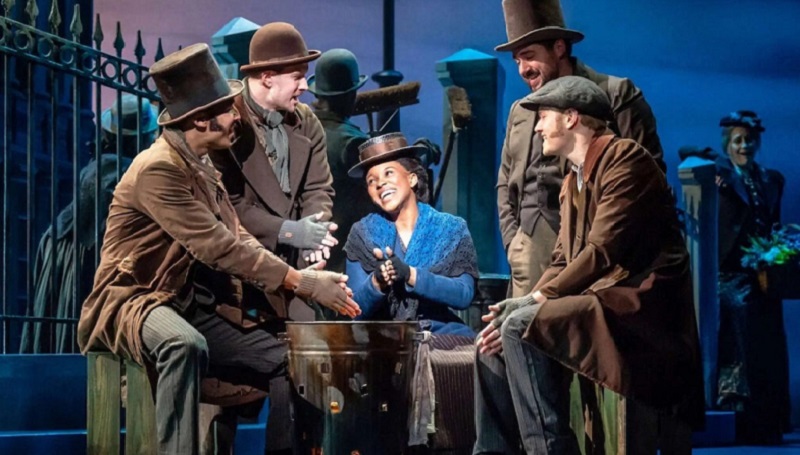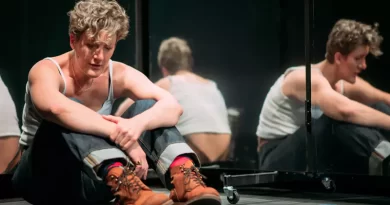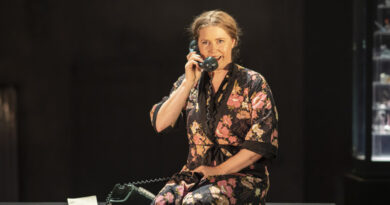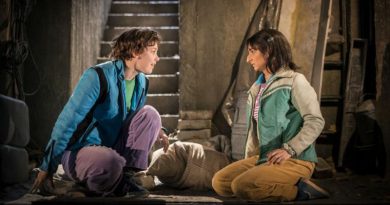“My Fair Lady” – Coliseum
Jeremy Malies in the West End
23 May 2022
The action of Lerner and Loewe’s My Fair Lady begins at St Paul’s, the so-called “actors’ church” in Covent Garden. Infamously, a production in Japan once misinterpreted this and reproduced the whole of Wren’s cathedral of the same name on the stage. I wondered momentarily if this was where we were headed when Michael Yeargan included the cathedral in his design but it was of course only the backcloth.
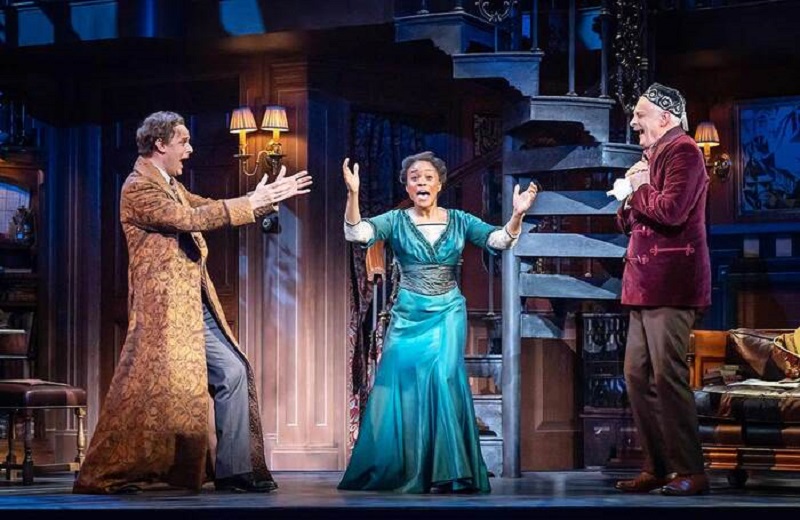
Harry Hadden-Paton, Amara Okereke and Malcolm Sinclair.
Photo credit: Marc Brenner.
This production is by the Lincoln Center Theater in Manhattan and directed by Bartlett Sher. It had a New York run in 2018–19 and now transfers to London, following hot on the heels of the transfer of the Broadway production of Rodgers and Hammerstein’s Oklahoma! to the Young Vic. Harry Hadden-Paton reprises the role of linguist and phonetician Henry Higgins opposite Amara Okereke who (like everyone else in the cast) is new to the part. (She was seen recently in London at the Almeida Theatre in a musical version of Spring Awakening.)
So does this 1956 piece age well? I’ve read carping reviews from shocked fourth-wave feminists who object to hearing Eliza described by Higgins as “baggage” when they should realize that Bernard Shaw was a feminist. It is Higgins and Colonel Pickering (Malcolm Sinclair as a genial buffer but suggesting depth) who are being satirized. Alan Jay Lerner was at pains to stress that he wanted to replicate the feminist content in the source material, Shaw’s play Pygmalion.
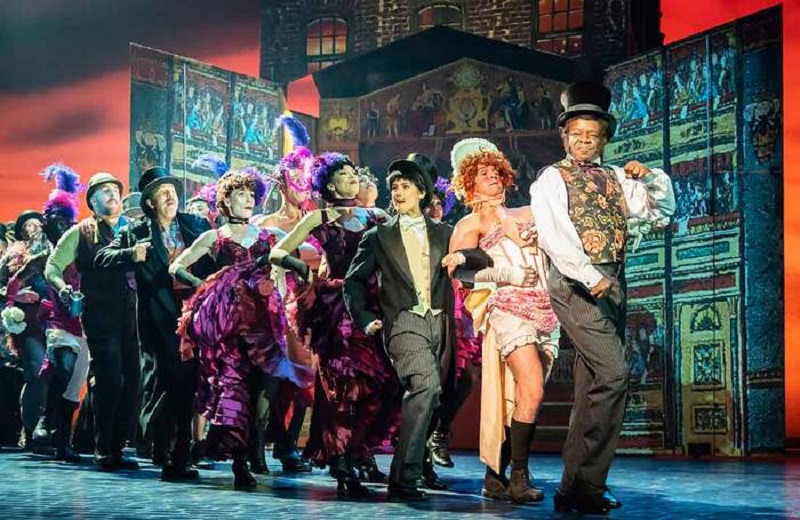
Stephen K Amos and company. Photo credit: Marc Brenner.
“Why can’t the English teach their children how to speak?” is one of Hadden-Paton’s first questions to the audience. The question doesn’t need to be asked on this occasion and there is no “cold-blooded murder of the English tongue”. Diction from every member of the generally young ensemble is either good cockney or credible Received Pronunciation with not a hint of the dreaded Estuary English from anyone.
Hadden-Paton is adept when hinting at emotional vulnerability behind the bluster. He is unusual in that his cajoling of Eliza rarely approaches the usual level of bullying. This is a Higgins who learns more from Eliza than she learns from him. The sometimes problematic song “Why Can’t a Woman Be More Like a Man?” is more quizzical and genuinely confused than misogynistic. I can’t believe that the consummately modest Rex Harrison (even when he won a Tony, and later an Oscar, for it) ever considered his version to be definitive, and his shade might be pleased by all this. Hadden-Paton is slimmer, slightly birdlike, more inquisitive and wears not so much as a square inch of tweed. It’s all very refreshing.
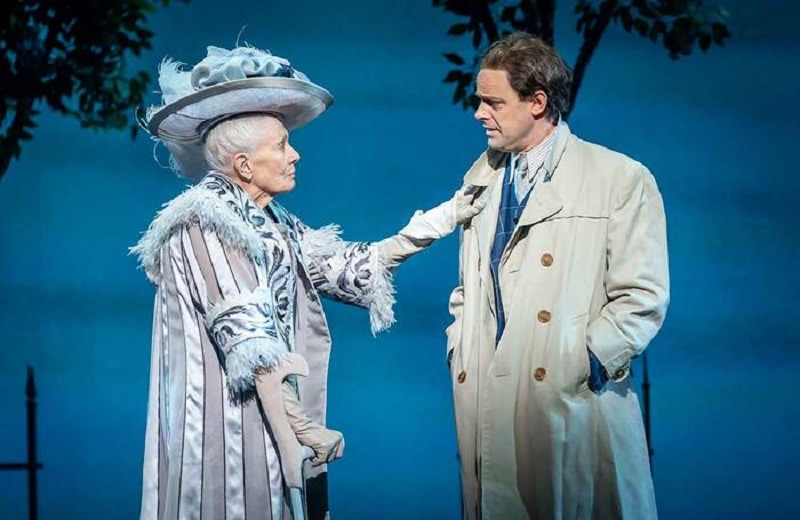
Vanessa Redgrave and Harry Hadden-Paton. Photo credit: Marc Brenner.
Okereke is just as impressive; I can’t remember when I last saw an actor truly exploring and interrogating a role where there is such a strong general opinion as to how it should be played. Lerner’s book, particularly during the flower-selling scenes, has some underwritten moments that oblige any Eliza to survive on her wits. Many resort to screeching and caterwauling but Okereke invests these sequences with true pathos. Her alternating at the tea party between aspirated ‘H’s and her character’s true accent – surely among the crown jewels of our musical comedy tradition – is a linguistic tightrope walk and close to perfection. “What I say is that them that pinched it done her in!”
Musically she is also magnificent, a highlight being “I Could Have Danced All Night”. The final note (a ‘G’) is a huge ask and many performers come in tentatively from the top. Okereke climbed to it magnificently.
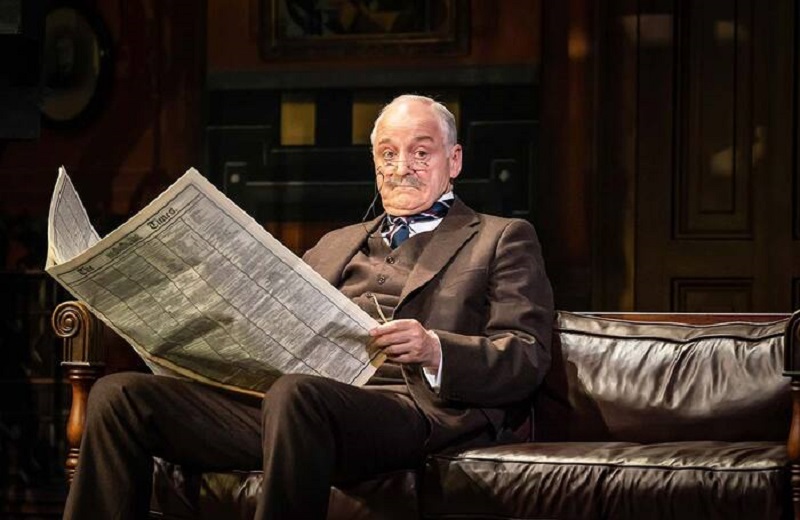
Malcolm Sinclair as Colonel Pickering. Photo credit: Marc Brenner.
As Alfred Doolittle, Stephen K. Amos impresses when fluctuating between true paternal feelings for Eliza and the exploitative attitude of a hopeless alcoholic who sees his daughter only as a commodity. In his pomp, you can leave the verdict on Doolittle to Higgins: “A natural gift for rhetoric … one of the most original moralists in England.” Okereke is equally skilful at moving from disgust at her father’s excesses to filial affection. When she tenderly adjusts his cravat and dusts down his lapels prior to a wedding that she refuses to attend I found myself swallowing hard.
The standard lazy approach to playing Mrs Higgins is to rely on Lady Bracknell mannerisms and an accent suggesting a glass chandelier being dragged down a marble staircase. This would not be good enough for 85-year-old Vanessa Redgrave who finds light and shade in the character. The scene in which Eliza is discovered being taught to paint landscapes in Mrs Higgins’ summer house features delicious girl power and a sense of solidarity between two women separated by a class chasm.
Sher and Dame Vanessa flesh the sequence out beyond its normal length, and it launches Okereke logically into the song “Without You” with the transformation suggested in the lyrics becoming believable: “What a mutton-headed dote was I! / No, my reverberating friend / You are not the beginning and the end.”
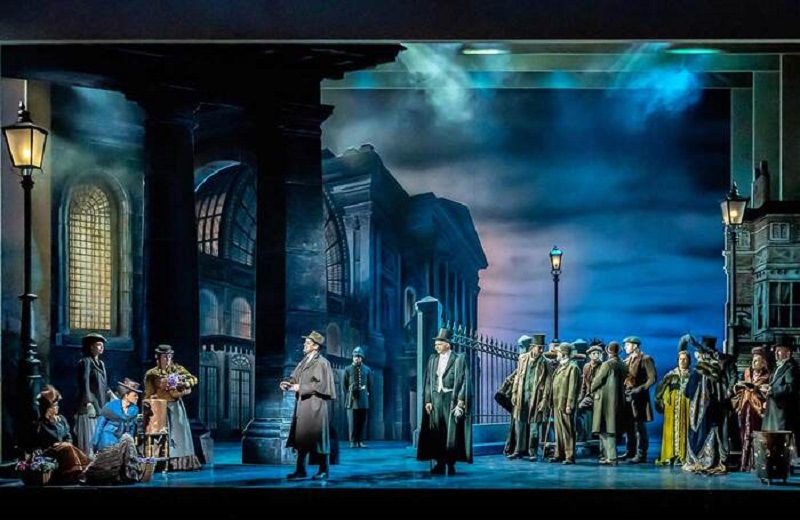
The company. Photo credit: Marc Brenner.
The final scene should see Eliza return to Higgins’ apartment and, not without a little doubt as to who might ultimately be wearing the trousers, submit to his will on domestic matters. Not so here. The ending doesn’t involve a technical flourish and can’t quite be described as a coup de théâtre but, for me at least, it was totally unexpected. Perhaps that’s because I have no fashionable scepticism about the patriarchy, perhaps it’s because Sher has the good judgement to leave everything delicately balanced and non-prescriptive in the run-up, relying as he should on the flexibility of the material. It’s best kept under wraps anyway but for me the final action is a thought-provoking twist.
At second press night a pulsating buzz (a malfunctioning speaker?) at the back of the stalls all but ruined proceedings for most of the first half. I don’t know how audible it was on stage or higher up in the theatre. A stronger-willed front-of-house manager (it would have taken some chutzpah, but I’ve seen it done at Glyndebourne) would have walked onto the tab, stopped the orchestra and brought everything to a halt until the problem was rooted out even if this involved individual musicians playing single notes to hunt it down.
And the English National Opera orchestra? It’s nearly 40-strong and Hadden-Paton himself has described it as “a wall of sound”. Apart from the instances when some stridency is required, musical director Gareth Valentine elicits lush sumptuous tones that positively invite the actors singing solos to step fully into the music.
There is always excitement in the press areas of the stalls or circle as we prepare for one of the biggest scene changes in world drama as the action moves from Higgins’ apartment to Ascot. But here the curtain comes up surprisingly quickly. Probably as part of Sher’s overall vision, Yeargan manages to depict a convincing racecourse with just a stripy canvas canopy above the stage and a few chairs. This decision is all of a piece with the general tone of originality and a theatrical equivalent of fleet-footedness. At other times, the set is more ambitious; the Wimpole Street apartment uses the Coliseum’s revolve and is on two storeys with Higgins able to rush up to his library and chambermaids singing as a trio draped on a spiral staircase.
There is so much to admire here but the levels of invention brought to the smallest bit of comic business prompted me to reflect on Sher’s work not just as a director of musicals and opera but of straight theatre right across its canon in terms of chronology and scale. Eleven years ago, his world premiere production of Two Boys by composer Nico Muhly was hosted here at the Coliseum by English National Opera. A few minutes’ walk away at the Gielgud Theatre, you can admire Sher’s direction skills in the London transfer of Aaron Sorkin’s adaptation of the Harper Lee novel To Kill a Mockingbird. It’s a delight that his work is back here, and we can wonder at the virtuosity and the breadth of source material.

